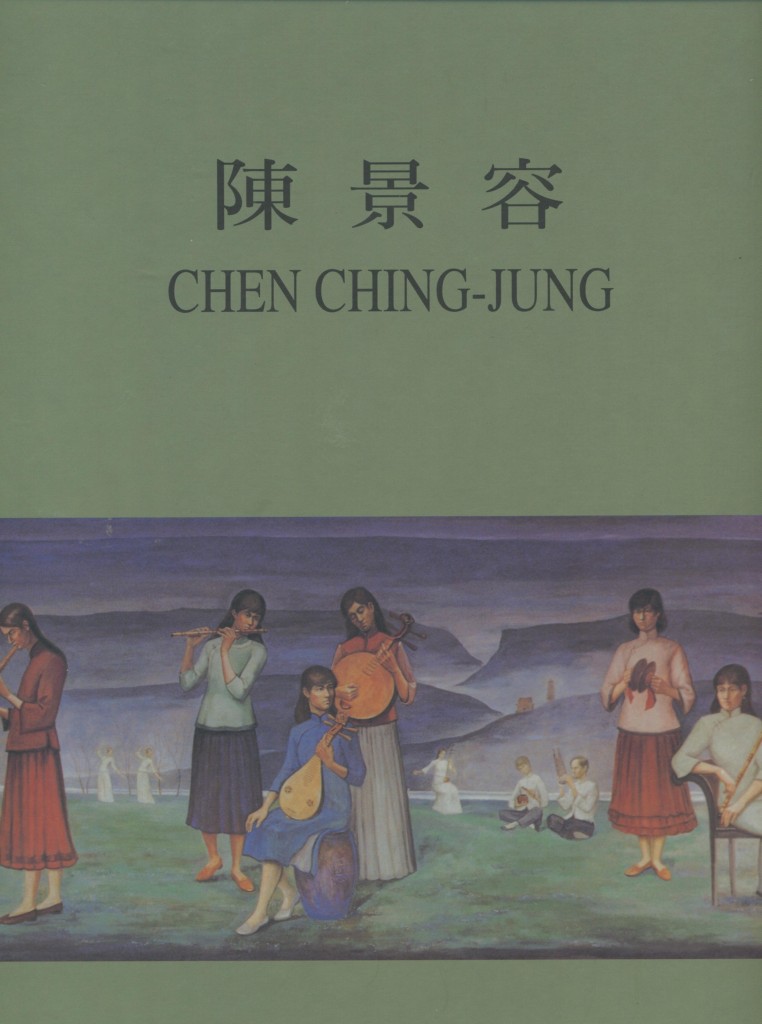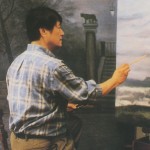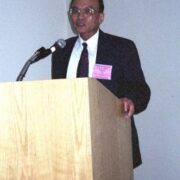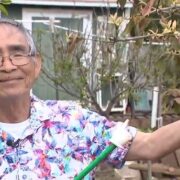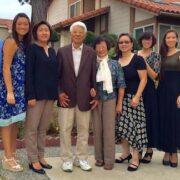陳景容(畫集)
畫家 陳景容
A decade has passed since I published The Painting Album Chen Ching Jung (I) in 1991. I have been fortunate in that iave kept my health and continued my art career as before. I ve chosen the more remarkable of a considerable number of )rks and added forty recent pieces to make a more complete llection.
In 1991, I bought an artist’s studio in the Antony suburb Paris, where I regularly spend winter and summer vacations. ;fore the studio, every time I went to Paris, I could only do atercolor landscapes or still lifes in the hotel. If I felt the urge 、paint in oil, I had to spread newspaper over the bed and set p my suitcases as an easel. It was quite inconvenient. No latter how hard I tried, I was unable to produce good work, he idea of buying a studio in Paris then came to my mind, iccordingly, when I had a year’s sabbatical in 1991, I smporarily dropped my teaching duties at the Taiwan Normal Jniversity and bought an apartment in Paris, where I stayed or one year and painted continuously.
Loneliness was hard to avoid when I lived in Paris, but it vas much easier for me to concentrate on painting without outside disturbances. I also enjoyed access to the multitudes of masterpieces in the museums. At that time, rapid economic development in Taiwan meant that Taiwanese art collectors began to grow in both quantity and quality. Artists had the opportunity to exhibit their works at art galleries and won direct and favorable responses from viewers. Art galleries often asked me for little pieces, but I thought my year in my Paris studio was a truly rare chance to be solely absorbed in the world of painting. Hence, I turned down their requests and devoted myself to the creation of large oil paintings in the hopes of excelling in French art circles.
The studio in Paris is located on an upper floor with tall trees all around. When I looked down from the windows, it seemed as if I lived in a forest. I always thought of my friends and family in Taiwan at dusk. When the clouds and mist gathered around, it was as if I were an immortal, and when the moon loomed in the evening, I was just like the legendary hero at the Kuang-Han Palace. The experience of living alone in a foreign country allowed me to shed the real world. The grand cemetery near my studio often reminded me of vampire stories when I woke up at night. The winter wind wailing through the woods especially gave me the feeling of living in a surreal world.
During that year, I traveled almost everywhere in Europe. Italy, with her rich art and cultural property, was my favorite country. I especially enjoyed the equestrian statues in the city squares, masterpieces left by the Renaissance geniuses. They reminded me of the drawings I did from plaster equestrian models when I studies at the Tokyo National University of Fine Arts and Music. The ancient streets and cathedrals also gave me the illusion of being in a world hundreds of years past.
Suddenly, I realized this would be a good theme for drawing. Through the statues with their strict human anatomy, I could express my realistic drawing ability, and the nostalgic sentiment for those ancient streets and squares aroused my inner desire to create some kind of metaphorical work.
The beginning pieces were only depictions of lonely squares, statues and streets, like the ancient street scenery and illusionary space in de Chirico’s metaphysical words. I constructed the pictorial space of the desolate ancient worlds solely with basic elements: points, lines and planes.
Little by little, I added some visitors in modern dress to the picture. These visitors walked back and forth without noticing the statues of the glorious heroes of old, revealing that no matter how magnificent the life of a man may be, he cannot escape the destined emptiness of death. I juxtaposed the ancient equestrian statues and modern people walking about to represent the sharp contrast of life and death. This remained the focus of my expression in that period.
After several works in the same series, I found the walking people in the square were too small and insignificant compared to the whole picture. I consequently added some figures, nudes sitting alone or lost in thought, and symbolic objects, like bull skulls and oil lamps, to the outdoor ancient equestrians to achieve a surrealist sense of anachronism in time and space. These large-scale works, measuring from 100F to 150F, took a great deal of time and effort. With their realistic portrayal of the subjects and unreasonable compositions, my works are better defined as symbolic rather than surrealist.
In my recent works, I have kept the nudes and still lifes in the foreground and added the completed oil painting, “Roman Square”, in the background. The contrast of real people and fictional space strengthen the grotesque atmosphere of the paintings and lead the audience into another fantastic world.
The subjects for the small pieces came from thoughts and feelings in daily life. In my Paris days, I had to manage life by myself, and the Interior setting, cooked food and dishes became the best subjects in my works.
I also juxtaposed still life with a seashore background. As Pai Hsueh-Lan wrote in Tradition et Continue: Taiwan Postwar Artists, In his still lifes, he depicts collected objects such as oil lamps, shells, bottles, water jars and daily things such as books, eggs, bowls, dishes, vegetables and fruit with their unique forms or meanings. With careful arrangement and composition, the plaster model coffee grinders, Bibles, shells, twigs, eggs, dishes and grapes by the sea make an ordered and compact picture. The moon just rising in the sky indicates the cycles of life. The shell is a symbol of the end of life and the egg a symbol of the beginning of life. The Bible and oil lamps have philosophical connotations, and the dolls and water jars are presented in the same way. They were the profound reflection and impressive marks of my solitary life in Paris.
Since I had studied mural painting in Japan for years, I spent lots of time researching Renaissance mural paintings while in Italy, especially the works of Francesco. Fresco materials dry quickly and therefore require a solid foundation of drawing techniques, including pure and steady tone, exact depiction and correspondence between work and the supporting architecture. All these have influenced my painting style; the monochromatic expression in particular is visible in my paintings. The series of squares, equestrian statues, nudes and still lifes are colored in gray and blue tones to stress the contrast and confusion of the present and the past, and to engender an atmosphere of sorrowful tranquility. I set the time of most of my pictures at dusk or evening, and lengthen the shadows to enhance the feeling of solitude.
I am convinced that artists express their inner feelings in their works. Paintings are not just the objective representation of \sisual reality, and it is the inner feelings, fantasy, poetic interests ancTphilosophical thoughts that count. Only after careful and repeated consideration do I begin sketches, then progress to detailed drawings, complete drawings and at last the final making of oil paintings.
In 1993,”Square in an Ancient City” was selected for the Salon d’Automne, and I was listed as a regular member of the same. In 1998, “Church and an Equestrian Statue” won the Medaille de Bronze for oil paintings in the Salon de Printemps and “An Equestrian Statue and a Nude”, also oil, won the Medaille d’Argent in the Salon des Artistes Francaises.
The Salon des Artistes Francaises has a long history. Its first exhibition was held in 1667,and originally only presented works of the Royal Academy. In 1793,academic interference was eliminated and the award system of the Medaille d’Or, the Medaille d’Argent and the Medaille de Bronze was established. Artists including Ingres, de Chirico, Delacroix, Corot and Manet all presented their works at the Salon des Artistes Francaises. Membership requires continuous selection For three years, and only members can compete for the Medaille de Bronze. So it was not easy for my “An Equestrian Statue and a Nude”, one of thousands of selected works, to win a
prize. This painting took me two years tocomplete^^^^ nude in this work was painted from hundreds of studies of the same French model, drawn over the course of five years.
In 2000, “Nude in the Studio” (150F) won the Medaille d Honor in the Salon des Artistes Francaises. Li Shu-Ying reported in the Pacific Times, The “Salon des Artistes
Francaises was held in Paris from November 17 to 26 this year. Professor Chen Chin-Jung’s oil painting, “Nude in the Studio”
(150F), one of700 selected works from all over the world, won the Medaille d’Honor. After winning the Medaille d’Argent lastyear, Professor Chen again gains worldwide recognition. The artist uses models, equestrian statues and Italian squares as his background and his unique personal style has become world-famous in the ficU of art. In “Nude in the Studio”, a square with four statues in is the background. At the back and left side of the nude, two aged men talk and walk along; at the right side, two young men ride on a bicycle. In the central part, a woman holds the hand of a child walking slowly. The motion of these background figures and the static of the foreground seated nude and still life create an amazing sense of rhyme and balance. All the subjects in the picture seem to lead the viewer between reality and fantasy, bathed in un atmosphere of mystery and peace. The viewer’s imagination is enriched. These words express the ideal and painting style that I strive for.
How many decades can a man have? In the recent decade, my life has undergone great changes. In my Paris studio, I have worked harder than before and have a much more positive attitude about international exhibitions. I am now one of the regular members of the Salon d’Automne and Salon des Artistes Francaises. These honors don’t seem to have anything to do with being an artist, but I actually spent a lot of effort on them. Why did I so vigorously participate in these exhibits? Perhaps it is the influence of several senior artists in Taiwan, including Yang Sun-Lang, Yen Shui-Lung, Liu Chi- Hsiang and Chen Ching-Fen. They often wrote, “work selected in Salon d’Automne “, as a record of their achievements.
I still recall that before one of my teachers, Chang Yi- Hsiung, left for Paris, he said he was “going to Paris to pass the Salon”. It was a pun expressing his will to “pass” the French Salon, and it immediately came to mind when I bought my studio in Paris.
The will to “pass the Salon” also has something to do with the reputation of my family. Even at my age, I sill have the childlike desire to compete with foreign artists. Accordingly, I began competing for selection in the Salons. But there are thousands of artists who would like to join the Salon des Artistes Francaises; only seven or eight hundred are selected,let
ilong win the incredible honor of the Medaille d’Or, the VIedaille d’Argent or the Medaille de Bronze. In the Deginning, I merely thought that there was no harm in trying since I was already in Paris. Winning or not winning a prize is not important for an artist. It seemed like a cheerful event for my family and friends in Taiwan, for a couple of days. As the Japanese proverb says, “some evil things are necessary in life”.
After the death of my aged and sick parents, my frame of mind has changed greatly. The heartfelt pain and sorrow reminded me of the uncertainty and the transitory nature of mortal life. As a result, I treasure my limited life all the more in the hopes of leaving behind many more good works of art. I still spend almost ten hours a day painting. Except for time spent teaching, eating and sleeping, I devote my entire mind to artistic creation. I have started to collect and sort out all my works from the past decades, and published two books, Old Temples of Nara and the Art of Mural Painting.
In the winter of 1997,the Taipei Fine Arts Museum held a large-scale retrospective exhibit for me, “Being and Images – 40 years of Chen Ching-Jung’s Vision”, which made a complete presentation of my essential works in every medium. In the show were drawings, watercolors, oil paintings, frescos, mosaics, crayon drawings and ceramic paintings. Some of them were large works – over 100F in size – from my Paris studio. As the director, Lin Mun-Lee, described in the foreword, Chen has devoted himself to the restoration of oil art and the development and promotion of such techniques as fresco and mosaic. His distinctive style is highlighted by the unique surrealist colors he uses and by the tranquil, mysterious and lonely impression left by his compositions. The enthusiasm for music, literature and philosophy that lie behind his exacting personality can be seen in the assemblages and morals that Chen crafts from the figures and objects found in the formal construction of his works. These figures and objects are placed throughout the themes he commonly uses in his paintings – people lost in thought, figures standing or lying by the side of a lake, musical performances by the sea or in the wilderness, Biblical or mythical stories. Because of his love of a simple and serene way of life, Chen frequently packs up his artist’s tools and sets out for the countryside or for some overseas destination. The objects most often seen in his works include sturdy cottages amidst natural settings, weather-beaten fences, people or livestock resting beneath trees and expansive landscapes of the sea or city boulevards. Because of his fondness for things of bygone days, his paintings of old ruins and folk customs give viewers a nostalgic impression and may also, in juxtaposition with modem life, sometimes stimulate deep thoughts about the nature of time, space and life.” On the grounds of social feedback, I always donate my painting albums and other publications to various libraries and universities. I also donate original works to local hospitals and cultural institutes like the TFAM and the
Kaohsiung Municipal Art Museum. Moreover, I was awarded the 2nd and 4th Wen Hsin Awards.
I have done as much as possible in the flourishing domain of public art. Beginning in 1998, I volunteered two years to create the magnificent mosaic, “Cure the Body and the Soul, See the Patients as their Parents” (2mxl0m), for the Mennonite Christian Hospital in Hualien. This work was made up of nearly 200,000 hand-cut pieces of marble and quartz bricks to achieve a lively portrayal of facial expression and a perfect pictorial structure. I hope my insignificant offering will inspire a greater contribution from the rest of society.
In 1999,the Chen Ching-Jung Fine Arts Museum was founded in Los Angeles, and its opening exhibition won high praises from both Chinese and other visitors. The museum has become an important art center for the overseas Chinese in Los Angeles, where then can enjoy and express their opinions about artwork. This is another place to present my works, in addition to the studios in Taipei and Paris. I plan to hold my solo exhibition there in June 2001.
Teaching and imparting my painting techniques and experiences still occupies my mind. In order to provide the art students of my school an opportunity for study and emulation,
I held a commemorative exhibit at the National Taiwan Normal University Campus Gallery, which included eighty- two pieces of work having different painting techniques. I also demonstrated the process of making large-scale oil paintings and the professional techniques of mosaic and murai paintings.
Painting is my second life. Even though being an artist is as hard as being a laborer, the joy of finishing one work and challenging another is still incredibly fascinating to me. I have never regretted engaging in hard labor for forty-five years. In fact, I am fortunate to lead such a life. I’m not afraid of solitude because it is the essences of artistic creation. For me, “artists must bear, even enjoy, the beauty of solitude”.
In the face of many unfinished works and works not yet begun, I wish I had another forty-five years to complete them.
I have lots of new ideas and techniques to explore, and many publications to revise. With so many tasks and so little time, I can only encourage myself to work harder and harder than before!
自從91年出版了《陳景容畫集1》之後,到現在 已經過了十年了,在這段期間,我仍繼續作畫,幸而身體還算保持跟年輕時相差不多的體力,因此作品也累積了相當多的數量,現在挑選比較具代表性的作品,增加四十頁放在原先的畫集之後,以充實內容。
1991年我在巴黎近郊Antony購置一間畫室,利用 寒、暑假的期間前往居住。在此之前,即使我到巴 黎,也只能利用水彩畫一些風景畫,或在旅館內畫靜物畫,即使有時想用油彩,也只能克難的在床上鋪一 張報紙,立起皮箱,充當簡便的畫架來使用,十分不便;儘管非常努力的作畫,也始終畫不出理想的作品。
因此,開始有了在巴黎買間畫室的念頭,91年正好輪到我教授休假一年,有機會暫時放下師大的教 職,也順利的在巴黎買到了房子,並繼續留在那裡畫了不少作品。
一個人居住在巴黎難免會有點寂寞,但少了外界的干擾,更能專心地作畫,也有更多的機會前往美術 館_觀研究,頗多收獲。這一年,台灣經濟起飛,收藏家開始積極蒐購繪畫作品,因此畫家們都有機會在畫廊展出,且獲得不錯的回響。當時畫廊常要我的小幅作品,但我認爲很難得的在巴黎買了一間相當不錯的畫室,能專心作畫正是夢寐以求的事。因此仍舊把作畫的重心放在繪製大幅油畫作品上,期待能在法國 畫壇佔有一席之地。
巴黎的畫室在高樓,四週有高大的樹木,站在窗口往下看,就像住在叢林裡,黃昏時分看晚霞總會想 起故鄕的人們,覺得十分孤單;當有雲霧的時候,又彷彿是像仙人置身在雲層裡,而晚上有月亮時,似乎自己就在廣寒宮。這次在巴黎不但一個人身處異鄕, 由於過去很少住過高樓,更讓我覺得像脫離了現實世界,不但如此畫室旁邊有一個很大的墓園,半夜醒來也會想起西洋吸血鬼的故事,尤其冬天,寒風吹過樹梢發出悽厲的聲音,令人心悚這一切都讓我以爲自己像住在超現實的世界裡。
住在巴黎的期間,有許多機會到歐洲各地旅遊, 我最喜歡的地方就是義大利。除了因爲義大利擁有豐 富的藝術資產之外,許多城市的廣場,往往有騎馬雕像,這些雕像也是文藝復興時期大師們的傑作,當我在東京藝大求學時,曾經畫過這些騎馬像翻成石膏像給我一個似乎置身於數百年前的世界的幻覺。
忽然我發現,這是一個很好的題材,描畫上,有高難度的雕像可表現我在素描上的功力,而古老的街 景、廣場,又帶給我一絲的感傷,引發我創作的慾望。剛開始的幾幅作品,只描繪冷清的廣場和雕像、 街景,就像形而上畫派的基里軻,所描繪古老的街道,營造出一種虛幻的空間感,這類作品看來就是一 個無人的古代世界,而畫面則是純粹由點、線、面而構成的。
慢慢地,我在畫面上加入一些現代穿著的遊客, 這些來來往往散步、漫談的人們,看來並不曾留意身 旁這尊曾經顯赫一時的英雄雕像,我想:「再如何絢爛的生命當面對死亡時,一切均歸於寂靜」,因此我把古代英雄騎馬像和在廣場散步的現代人並置於同一空間,象徵了生與死的對比,形成我此階段作品的表現重心。
畫了幾幅這類作品後,我發覺在廣場上散步的人們都只能畫得小小的,有時看來會顯得瑣碎些,於是 我再將慣用的人體造型放進畫面,在室內有獨坐的裸女,或沈思、或冥想,配上具有象徵意義的靜物,如 牛頭骨、油燈之類,與窗外古代英雄的騎馬像形成時空倒錯的超現實感,如此在造形上看來也較爲大方! 這些作品大多是一百號到五百號之間的大幅作品,作畫時頗費心力。描繪上我仍舊很寫實,只是以不合理的安排來經營構岡,因而與其說我的作品具有超現實的風格,不如說更接近象徵主義的。
至於近日的創作,除了保留前景的裸女和靜物之外,背景部份則加上大幅已完成的油畫「羅馬的廣 場」,如此一來,在眞實的人物和背景部份的虛構作空間的對比之下,更加強了虛虛實實的怪誕氣息,當觀賞人們作品時,會不自覺地進入另一個想像世界。
至於一些小品畫作的題材多來自日常生活,和心中有所感觸的靜物畫。例如在巴黎居住的期間,我- 個人生活,起居飮食都得自己打理,屋內的擺設,拜餐前的菜餚、用餐後的碗盤,也都是很好的題材。
除了這類較屬於寫實的作品之外,我也在靜物之外再配上海邊風景,這類作品正像白雪蘭在「傳統與創新——台灣戰後第一代畫家」一書中所提及:「靜物畫中採用他的收藏品如油燈、貝殼、酒瓶、水壺, 與生活上的物品如書、蛋、碗、盤、蔬果。他用它們排列組合,有時取其造形有時取其意涵。如寂寞的海邊有石膏像、磨咖啡器、聖經、貝殼、樹枝、蛋、 盤、葡萄,造形、位置排列、高低都經過思考才使畫 面緊湊,而意涵上天際的月亮剛剛昇起,表示周而復始,貝殼象徵生命的結束,蛋象徵生命的開始,聖經、油燈有哲學的意念,另外布偶與水壺的靜物都是相同風格。」反映了我在巴黎孤獨的生活和不斷創作 的痕跡,另有一番深意。
因爲留日期間曾鑽研過壁畫,我到義大利時也用 心研究文藝復興時期的壁畫,其中最喜愛法蘭契斯卡 的作品,由於媒材易乾的特性,繪製溼壁畫需要具備良好的素描基礎,色調單純而沉穩,下筆要精準作品也要和建築相搭配,這一切都影膂了我的畫風,也因此較偏好單色調的表現。而廣場、騎士、雕像、裸女 和靜物這一系列作品,我便選擇以藍灰色調處理,正突顯邊中時空交錯和古今對照、物換星移的寂寥,也增添了作品中一貫的寧靜與哀愁的氣氛。爲了配合主題,我特地把畫中的時段大都設定在心情較爲平靜的黃昏或夜晚,偶爾也刻意拉長主題的陰影,以增加孤寂的效果。
我認爲畫家必需要把内心的感受表現在畫面上, 繪遵並不只是客觀的視覺再現,繪遠應該表現内心的 感受、幻想、詩趣和崇高的思想才有内涵,當我作畫時構阖都是經過審愼的思考、反覆推敲、由畫速寫、 局部素描、完成等大素描稿之後才開始著手畫油畫。
經過一段努力不懈的創作下,我在1993以作品 「古城廣場」,入選法阈秋季沙龍,並在同年成爲法阈 秋季沙龍的永久會員。1998年又以「教堂與騎士雕像」 榮獲法國春季沙龍的油畫銅牌獎,更在1999年以油畫 《騎士雕像與裸女》在法阈藝術家沙龍榮獲銀牌獎。 原來法阈藝術家沙龍是法國歷史相當悠久的沙龍,第 一次展赀始於1667年,原爲皇家學院成員的作品展, 1793年脫離學院的干預,設立獎赏制度,即現在的 金、銀、銅牌獎,過去曾在此沙龍參展的畫家有安格 爾、基里軻、德拉克勞窪、柯羅、馬奈……等人。欲成爲藝術沙龍的會員,必須連給三年入選,不能間 斷,才能成爲會員,之後才具備資格參選銅牌獎,以此類推:由此可知,《騎士雕像與裸女》能在參展的 近千幅人選作品中得獎其赏也不容易,這幅作品我花了兩年的時間才完成,裸女部份是五年來,從畫同一 位法國模特兒坐姿的上百幅素描習作中挑選出來,再用心配上合適的背景,可說花了不少心血。
2000年時我再以150號的「畫室的模特兒」獲得 榮譽獎。如李淑樱小姐在太平洋時報中刊戴:「今年11月17日至26日在巴黎舉行的法國藝術家沙龍,陳教 授以一幅150號的作品,『畫室的模特兒』,在參展的 700位國際畫家中脱穎而出,獲得榮譽獎。爲陳教授 去年(1999年)獲銀牌獎之後,再傳佳音。陳教授以模特兒以騎士、雕像、義大利廣場爲畫面背景的構思,在他本人來説,不論在取材、構思上都已巧具神功,而他獨樹一格的畫風則聲譽國際畫壇。就『畫室的模特兒』來説,作品中属於背景的廣場,遠處有四座雕像,在模特兒的背面左側有兩個老人一面交談一 面走過來,而右側則有兩個年輕人騎著腳踏車,在中央部份有一位婦人牽著小孩子在緩步前行。這些動態 的背景人物與端坐前方的模特兒及放置地板上的靜物,在動、靜之間製造了有趣的律動與協和。筆者個人的直覺上,任何題材出現在陳教授的畫面,總是讓人不自覺的會在現實與虛幻中遊走,並在靜謐中享有一份神秘與安祥,擴大了觀賞者的想像空間。」這也道盡一向堅持的理想和努力經營的個人風格,終能獲 得法阈藝術界的肯定,增加我的信心,覺得並沒走錯方向。
人生不知有多少倘十年?近十年對我來說有很多變化,在巴黎有了畫室之後,努力作畫,積極參加沙 龍展,目前已成爲法國秋季沙龍和法國藝術家沙龍的永久會員了。這些事蹟看來似乎和當個畫家並沒有直 接關係,反而耗費我相當大的心力,參展前還會相當緊張用心作畫!那麼爲什麼還舍參加沙龍呢?可能是受到台灣前輩畫家們的影響吧!像楊三郎、顏水龍、 劉啓祥和陳清汾……等人到巴黎留學回國之後,在畫 歷上總是寫著「乂乂年入選秋季沙龍」的文字,當作留法期間的成績單。
而我的老師張義雄赴巴黎定居前,也曾說了一句雙關語:「到巴黎要Salon pas (撒隆巴斯)!」拆開來解讀便是作品要在法國的沙龍(Salon)入選 (pass),似乎正暗示此行至少要在沙龍入選其作品, 所以當我在巴黎買了畫室後,就想起老師的這一句話。其實說來有趣,“Salon pass”的動機,多少帶有將來回國時,好向家人交代的意思。其次是我到了 這把年紀仍然童心未泯,想著和外阈畫家比削比;削又何妨,心中暗想:「他們這種程度,對我來說,……」 於是開始參加了沙龍的徵選。但是法國藝術家沙龍往往有數千人送作品,入選只挑出其中七、八百件,並不是那麼容易的事,如果要得到金、銀、銅牌的獎 項,更是難上加難。當初我開始送件時只是抱著既然人在法國,就姑且一試的心情,老實說得獎與否對一位畫家而言,並不重要,不過得了獎,也可以讓台灣 親友高興幾天,就是如此而已,在日本有句話,說 是:「人生也有『必要惡』」,大概就是指像這類的 Salon pass吧!至於,實質上的收穫呢!說實在的參展得獎的作品還是近年來最用心的代表作,另外也俘 虜了一大牛皮紙袋,從各國畫廊寄來的邀請函。
這些年來,隨著中風十六年的父親和纏綿病榻的 母親相繼去世,我在心境上也歷經轉折,傷痛之餘更 是感受到生命的無常和苦短,於是格外珍惜僅存有限 的時間,渴望創作更多好的作品。直到現在,每天我 作畫的時間仍長達十小時之久,幾乎可以說,除了上課、吃飯與睡覺的時間之外,將全部的精神都放在創作上。也開始著手整理數十年來的作品,也出版了 「奈良的古寺」、「壁畫藝術」和修訂了三本己出版的 割乍。
1997年冬天,我有機會在台北市立美術館舉辦了 大規模的「陳景容創作四十年展」,以「存在和意象」爲主題,展出了我的繪畫生涯各時期的精華,包括有 素描、水彩、油畫、壁畫、嵌畫粉彩、版畫和彩瓷 畫,其中有不少是在巴黎所畫的一百號以上的大幅作 品,完整地呈現多年來創作的心得和各種領域鑽研的 成果頗獲好評,我的作品如同白雪蘭在《傳統與創新–台灣戰後的第一代畫家》中所述:「在陳景容從未間斷的繪畫生命裡,其風格也經歷數變,但不變的是他的畫風向來以堅實的素描、嚴謹的構圖爲基礎, 灰藍色調的色彩數十年如一日,慣用的物件重複排列組合,搭配空曠的空間與遠闊的地平面,使畫面呈現 寧靜清遠與神秘寂寥的感覺。這種畫作的完成,畫家在畫面構成思考上花很多時間,但感情是内斂而深沈的表達。而畫家的個性使他感覺内心是寂靜愁的,所 以喜歡表現孤淒清冷的意境。」
爲了回饋鄕土和社會,除了經常把自己的畫冊和其他出版物致贈各國圖書館和大學之外,也常把自己 的畫作捐給各地的醫院和文教機構典藏,台北市立美術館和高雄市立美術館也都有我捐贈的畫作,而獲得 文建會頒發的第二屆及第四屆文馨獎。
另外我對公共藝術也是竭盡所能貢獻微力,1998年,更是用了兩年的功夫義務爲花蓮門諾醫院的: 製作了一幅命名爲「醫身醫心,視病猶親」的由古典大幅壁畫,這幅(2公尺X10公尺)的嵌畫完是由手工切割將近二十萬片的大理石和石英磚組合的,力求構圖的細腻完美,人物表情栩栩如生;如此的奉獻只期望能收到拋磚引玉的功效,讓有能力的人也能回饋社會!
1999年,在美國洛杉磯也設立了陳景容美術館,在佔地頗廣的展覽廳中掛滿了作品中外人士參觀= 頗有好評,儼然成爲國人在洛杉機的華社的一個塞 重點,可讓人悠閒欣賞作品,有時也聚會討論繪耋 術。這是我除了在台北和巴黎的畫室之外,另一作 國外展示畫作的據點;2001年六月我也將在這裡等個展。
然而,在我心中念念不忘的還是學校中的教育工作,爲了讓美術系同學有學習觀摩的機會,2000年 二月,我在師大畫廊舉辦大規模的紀念展,並挑選各種不同技法的代表作八十二幅,也展示了大幅油 作品的製作過程,以及馬賽克嵌畫和壁畫剝離術等內少見的專業技法。
也許由於近年來,我在繪畫上的努力和對社會奉獻回饋,所以經各方的引薦,我在2000年被遴選 台北市榮譽市民,今年五月,更獲得榮譽文藝獎的株榮,肯定了我在藝術上的成就,除了感謝大家的厚: 之外,我將會秉持對繪畫一貫的熱誠,繼續努力。
繪畫對我來說,已經成爲我的第二生命,其實畫家的工作正像台語的「做工」那麼辛苦,當一件作品完成後的喜悅總是短暫的,接下來又得面對另一次創作的挑戰,和數不盡的難題等著去解決。
至今我始終不曾後悔這種「做工」的歲月,手不離筆地過了四十五年的繪畫生涯。我也爲自己慶幸能有這種生活,我的個性是不怕孤獨的,藝術創作本來就是如此,因爲「畫家必須耐得住寂寞,有時寂寞也是很美的。」
面對數量龐大未完成的作品,但願上蒼能再賜我四十五年的光陰,今後我想要畫的作品還有很多, 也有不少新的構想,和探討新的技法,另外有很多尚待修訂的著作,算一算有這麼多工作,等著我來完 成,但願今後能夠好好利用剩下不多的時間,只好對自己勉勵:「努力,努力再努力」
Birthday : December 28, 1934
Native Place : Changhua County, Taiwan
Address : No.26-3, Lane 101,Roosevelt Rd., Sec.2, Taipei City, Taiwan, R.O.C. 02-23626605 02-23635841
ACADEMIC BACKGROUND
1967 • Graduated form the Tokyo National University of Fine Arts and Music, Tokyo, Japan
1965 • Graduated from the Gakugai University, Tokyo, Japan
1963 • Graduated from the Musashino University of Fine Arts, Tokyo, Japan
1956 • Graduated from the Dep. of Fine Arts,National Taiwan Normal University
WORKING EXPERIENCES
1968 • Returned to Taiwan, Full-time lecturer of Art at the National Academy of Arts, Banchao , Part-time lecturer of Art at the Chinese Cultural College, Taipei
1972 • Director of Department of Fine Arts, National Academy of Arts, Banchao
1977• Full-time Professor at the Department of Fine Arts, National Taiwan Normal University
1978• Professor at the Graduate Institute of Fine Arts, National Taiwan Normal University
1992 • Member of the Screening Committee of the 13th National Art Exhibition
1993 • Elected as a member of the painting section of the Salon d’Automne
1999 • Awarded the silver medal in 2nd Wenhsin, Award Recommended as an Honorary Citizen of Taipei City
Chen Ching-Jung is professor of the Undergraduate and Graduate Schools of Fine Arts at National Taiwan Normal University, Taipei.
畫家 陳景容
1934年12月28日出生於台灣彰化
通訊處:台北市羅斯福路二段101巷26-3號
TEL : 02-23626605 02-23635841
學歷
1967 東京藝術大學壁畫研究所畢業
1965 東京學藝大學畢業
1963 武藏野美術大學畢業
1956 師大美術系畢業
1968 回國於國立藝專及中國文化學院美術系任教
1972 任國立藝專美術科主任
1977 任師範大學美術系專任教授
1979 任師範大學美術研究所專任教授
1992 「第13屆全國美展」擔任評審委員
1993 獲選爲秋季沙龍油畫部會員
1999 榮獲第二屆文馨獎銀獎及被選爲台北市榮譽市民
現任 國立台灣師範大學美術系及研究所專任教授
Posted in 2015/01

